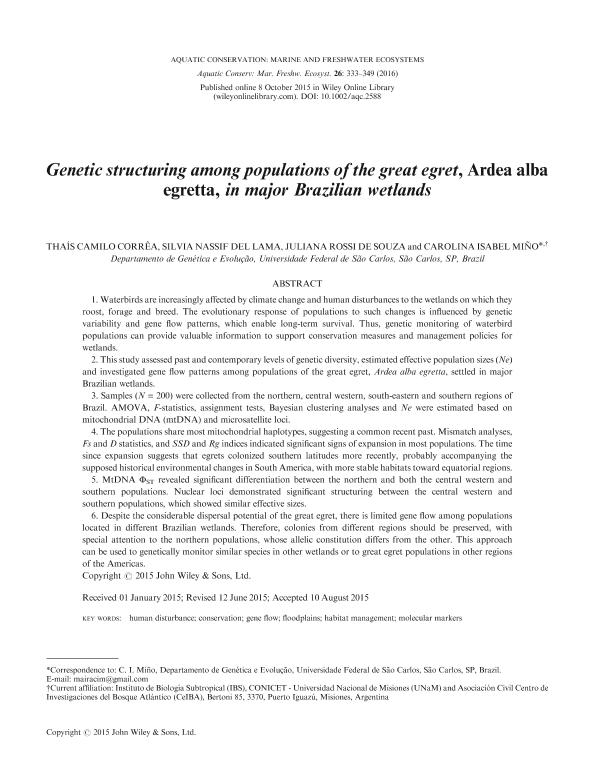Mostrar el registro sencillo del ítem
dc.contributor.author
Corrêa, Thais Camilo
dc.contributor.author
Del Lama, Silvia Nassif
dc.contributor.author
de Souza, Juliana Rossi
dc.contributor.author
Miño, Carolina Isabel

dc.date.available
2019-06-11T21:34:25Z
dc.date.issued
2016-04
dc.identifier.citation
Corrêa, Thais Camilo; Del Lama, Silvia Nassif; de Souza, Juliana Rossi; Miño, Carolina Isabel; Genetic structuring among populations of the great egret, Ardea alba egretta, in major Brazilian wetlands; John Wiley & Sons Ltd; Aquatic Conservation: Marine and Freshwater Ecosystems; 26; 2; 4-2016; 333-349
dc.identifier.issn
1052-7613
dc.identifier.uri
http://hdl.handle.net/11336/78008
dc.description.abstract
Waterbirds are increasingly affected by climate change and human disturbances to the wetlands on which they roost, forage and breed. The evolutionary response of populations to such changes is influenced by genetic variability and gene flow patterns, which enable long-term survival. Thus, genetic monitoring of waterbird populations can provide valuable information to support conservation measures and management policies for wetlands. This study assessed past and contemporary levels of genetic diversity, estimated effective population sizes (Ne) and investigated gene flow patterns among populations of the great egret, Ardea alba egretta, settled in major Brazilian wetlands. Samples (N = 200) were collected from the northern, central western, south-eastern and southern regions of Brazil. AMOVA, F-statistics, assignment tests, Bayesian clustering analyses and Ne were estimated based on mitochondrial DNA (mtDNA) and microsatellite loci. The populations share most mitochondrial haplotypes, suggesting a common recent past. Mismatch analyses, Fs and D statistics, and SSD and Rg indices indicated significant signs of expansion in most populations. The time since expansion suggests that egrets colonized southern latitudes more recently, probably accompanying the supposed historical environmental changes in South America, with more stable habitats toward equatorial regions. MtDNA F(cyrillic)ST revealed significant differentiation between the northern and both the central western and southern populations. Nuclear loci demonstrated significant structuring between the central western and southern populations, which showed similar effective sizes. Despite the considerable dispersal potential of the great egret, there is limited gene flow among populations located in different Brazilian wetlands. Therefore, colonies from different regions should be preserved, with special attention to the northern populations, whose allelic constitution differs from the other. This approach can be used to genetically monitor similar species in other wetlands or to great egret populations in other regions of the Americas.
dc.format
application/pdf
dc.language.iso
eng
dc.publisher
John Wiley & Sons Ltd

dc.rights
info:eu-repo/semantics/openAccess
dc.rights.uri
https://creativecommons.org/licenses/by-nc-sa/2.5/ar/
dc.subject
CONSERVATION
dc.subject
FLOODPLAINS
dc.subject
GENE FLOW
dc.subject
HABITAT MANAGEMENT
dc.subject
HUMAN DISTURBANCE
dc.subject
MOLECULAR MARKERS
dc.subject.classification
Otras Ciencias Biológicas

dc.subject.classification
Ciencias Biológicas

dc.subject.classification
CIENCIAS NATURALES Y EXACTAS

dc.title
Genetic structuring among populations of the great egret, Ardea alba egretta, in major Brazilian wetlands
dc.type
info:eu-repo/semantics/article
dc.type
info:ar-repo/semantics/artículo
dc.type
info:eu-repo/semantics/publishedVersion
dc.date.updated
2019-05-10T14:10:05Z
dc.journal.volume
26
dc.journal.number
2
dc.journal.pagination
333-349
dc.journal.pais
Reino Unido

dc.journal.ciudad
Londres
dc.description.fil
Fil: Corrêa, Thais Camilo. Universidade Federal de Sao Carlos; Brasil
dc.description.fil
Fil: Del Lama, Silvia Nassif. Universidade Federal de Sao Carlos; Brasil
dc.description.fil
Fil: de Souza, Juliana Rossi. Universidade Federal de Sao Carlos; Brasil
dc.description.fil
Fil: Miño, Carolina Isabel. Universidade Federal de Sao Carlos; Brasil. Consejo Nacional de Investigaciones Científicas y Técnicas. Centro Científico Tecnológico Conicet - Nordeste. Instituto de Biología Subtropical. Instituto de Biología Subtropical - Nodo Puerto Iguazú | Universidad Nacional de Misiones. Instituto de Biología Subtropical. Instituto de Biología Subtropical - Nodo Puerto Iguazú; Argentina
dc.journal.title
Aquatic Conservation: Marine and Freshwater Ecosystems

dc.relation.alternativeid
info:eu-repo/semantics/altIdentifier/url/https://onlinelibrary.wiley.com/doi/abs/10.1002/aqc.2588
dc.relation.alternativeid
info:eu-repo/semantics/altIdentifier/doi/http://dx.doi.org/10.1002/aqc.2588
Archivos asociados
